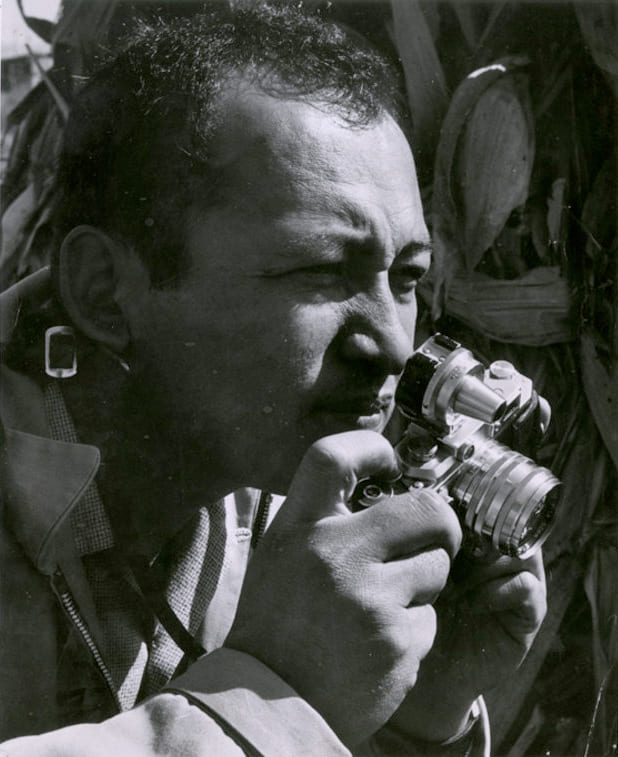

The undeniable existence of the apparently invisible, the dignity of the seemingly
insignificant, and
the quest for an esthetic to render their testimonies were at the heart of Nacho López’s
photography for
illustrated magazines during the 1950s.
Digital resource

He constructed his own definition of "lo mexicano" by documenting the plurality of many
Mexicos
in his photoessays about “worlds apart”. The poor, the prisoners, and the Amerindians who peopled
some
of his finer photoessays were distant from the middle-class readers of the illustrated magazines.
And,
they also came from other universes than the homogenous vision offered by the party dictatorship of
the
pri (Partido Revolucionario Institucional): presidential
preeminence,
the monopoly of power, the skilled manipulation of mass organizations, and the dilution of class
difference and ideology in the dissolvent of nationalism.
He explained his critical position by referring to his early education, “The socialist education I
received as an adolescent during the reign of Lázaro Cárdenas (1934-1940) left a profound imprint on
my
soul.” Fusing social commitment with formal exploration makes him part of a very select company of
great
photographers, including Tina Modotti, Paul Strand, Walker Evans, Dorothea Lange, Paolo Gasparini,
Sebastião Salgado, and the photographer who most he admired and resembles, W. Eugene Smith. And it
is
precisely that dialectic that made Nacho the extraordinary imagemaker he was.
His photoessays were published in the most important Mexican illustrated magazines, among them,
Hoy, Mañana, y Siempre! (Today, Tomorrow, Always!). He always worked for
weeklies,
never in newspapers, and almost never covered hard news. In fact, I do not believe that his metier
was
spontaneous or street photography, but the magazine genre of “features” made up of human interest
stories. However, photojournalism is a very wide field, and the capacities of photographers should
be
understood to be as varied as those who write. In spite of the general perception of him as a
photoreporter, I think he would be better described as a photoessayist in the majority of his
publications.
John Mraz
The hundredth anniversary of his birth provides opportunity to remember the artist, his images, his
ideals, everything that shaped one of the most important photographers of 20th century Mexico. Ignacio
López Bocanegra (Tampico, November 20, 1923 - Mexico City, October 24, 1986), better known as Nacho
López, was driving force of photography who pushed far beyond conventional, established, and authorized
limits. A man of lofty ideas and left-wing convictions, he showed us a very different path for
approaching photography. His camera recreated photojournalism, photoreportage, and above all, innovated
with photo essays—, an avant-garde journalistic genre —alongside editors José Pagés Llergo and Regino
Hernández Llergo. With the coming of Nacho López, photographers became professionals, independent
creators with their own visual grammar, catapulting the profession to another level within the editorial
and journalistic world.
It is important to note that Nacho López revealed an unusual Mexico in his work; that of the
underworlds, a Mexico that slumbered while life continued on the surface, that of the helpless or
dispossessed. Concurrently, he also worked with other subjects such as dance, music, the city,
architecture, the countryside, indigenous people in their native land, objects, and a vast array of
unusual themes for photography at that time. The genre overflowed with the everyday, treated with a
sharp sense of humour, accentuating social and political contradictions. In addition to an aesthetic he
developed, his images would penetrate diverse worlds, he was a great teacher and example with his
camera, always at the ready. It was part of his way of conversing, contrasting, discussing; he taught
his students a sharp-witty and fierce visual discourse. López was one of the few photo creators who used
printed words to show us the paths of visual militancy and the need to construct a discourse that would
surpass the known. He revealed, taught, and exercised that historical visual consciousness and from it
we learned how to comprehend the importance of photography as a documentary, historical, social, and
aesthetic source. Furthermore, his interest led him to cinematography with the same zeal.
In the case of this exhibition, it is an honour to share the words and curation of researcher and photo
historian John Mraz—the most prominent specialist in the work of Nacho López, who presents the
photographer on the hundredth anniversary of his birth through the full force and quality of his images.
Thanks to John Mraz, new generations will be able to familiarize themselves with one of the best
photographers in Mexico.
Rebeca Monroy Nasr
deh-inah
John Mraz
John Mraz
Instituto de Ciencias Sociales y Humanidades
Benemérita Universidad Autónoma de Puebla
John Mraz is Research Professor Emeritus at the icsyh-buap and National Researcher Emeritus. He has
published more than 250 articles, book chapters, and essays in Europe, Latin America, and the United
States on the uses of modern media in recounting history. Among his recent books are History and
Modern Media: A Personal Journey; Photographing the Mexican Revolution: Commitments,
Testimonies,
Icons; Looking for Mexico: Modern Visual Culture and National Identity; and Nacho
López, Mexican
Photographer. He has directed award-winning documentaries, and curated many international
photographic exhibits. His most recent documentary, Julio Mayo: Bracero with a Camera, and
exhibit,
Braceros, Photographed by the Hermanos Mayo, is currently circulating in U.S. universities and has
been viewed by more than 140,000 visitors.
Mraz, John, Nacho López y el fotoperiodismo mexicano en los años cincuenta, México, Editorial
Océano / inah, 1999.
_________, Nacho López, Mexican Photographer, Minneapolis, University of Minnesota Press,
2003.
Nacho López, fotógrafo de México, Homenaje, México, inba /
Museo de
Bellas Artes, 2016.
Revista Luna Córnea,
núm. 31, Secretaría de Cultura, Centro de la Imagen, 2007.
Rodríguez, José Antonio y Alberto Tovalín Ahumada (eds.), Nacho López, ideas y visualidad,
México, inah / sinafo /
Universidad Veracruzana / Fondo de Cultura Económica, 2012.